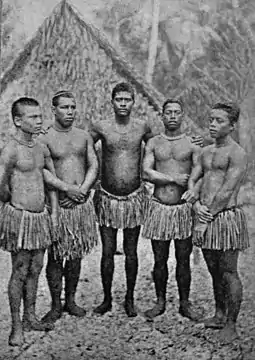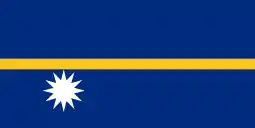Obesity in Nauru
Obesity in Nauru is a major issue for the Republic of Nauru. The World Health Organization's (WHO) estimated that 94.5% of Nauruans were identified as overweight and obese,[1] with an obesity rate of 71.7%.[2]


Nauru is known to have the highest rates of obese inhabitants worldwide.[3] The average body weight among Nauruans is approximately 100 kilograms (220 lb).[2] Nauru has an average BMI between 34 and 35. [4]
Causes

The causes of obesity in Nauru are due to multiple factors.
The culture of Nauruans consists of fishing and gardening. The Nauruan diet was primarily composed of marine fish, fruits,[2] root vegetables, and coconuts.[3] Nauru gained independence in 1968 due to an increase in economical growth from mining activities. The garnered profits were distributed amongst the citizens, leading to an outflux in citizen' labor. The Government of Nauru and WHO stated that the import of western food significantly reduced the existing culture of fishing and gardening, which led to mineral depletion and economical downturn of the nation.
From the 1980s, Naruans led a sedentary lifestyle and an unhealthy diet, contributing to "the worst health conditions in the Pacific region".[2]
90% of the land area of Nauru is covered with phosphate deposits, with the majority strip-mined and inarable. This had led to the reliance for Naruans on processed food imports,[3][5] high in both sugar and fat,[3] from large Oceanian countries such as Australia and New Zealand.[5]
The University of Queensland professor and South Pacific researcher Clive Moore stated that obesity is seen as a sign of wealth in Nauru.[3]
The lack of physical exercise, health literacy and improper health education alongside the cultural preference of obesity have been identified as factors contributing to the high obesity rates in Nauru.
Consequence
Nauru has the highest rate of adult diabetes worldwide. The International Diabetes Federation (IDF) identified 31% of Nauruans as diabetic,[5] with rates as high as 45% among individuals aged from 55 to 64 years.[3]
Efforts to treat obesity
Nauruan health authorities have developed several measures to reduce obesity, such as advising people to walk around the perimeter of the Nauru International Airport, which measures to 3 miles (4.8 km) in distance. Additionally, exercise sessions and sports are regularly organised.[3]
See also
References
- Streib, Lauren (2 August 2007). "World's Fattest Countries". Forbes.com. Retrieved 23 January 2013.
- Nishiyama, Takaaki (27 May 2012). "Nauru: An island plagued by obesity and diabetes". Asahi Shimbun. Retrieved 23 January 2013.
- Marks, Kathy (26 December 2010). "Fat of the land: Nauru tops obesity league". The Independent. Retrieved 23 January 2013.
- Laurance, Jeremy (4 February 2011). "How tiny Nauru became world's fattest nation". The Independent. Retrieved 23 January 2013.
- Streib, Lauren (2 August 2007). "Nauru: 94.5 % overweight". Forbes.com. Retrieved 23 January 2013.
